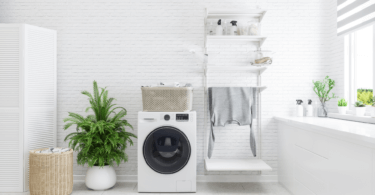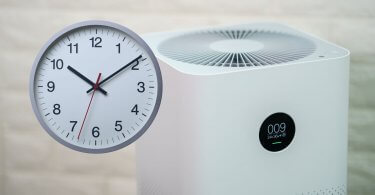If you are here, you most likely have a dirty, clogged HEPA filter and wonder if you should clean or replace it. Well, asking ‘Can You wash a HEPA filter’ is a common question, and there are mixed responses to it.
Some experts say that you just have to bang out the dust, and you can start using it.
Then other experts advise cleaning it with your vacuum cleaner.
The third group of experts recommends replacing instead of cleaning HEPA filters and that you should never clean a HEPA filter. They state that there is a chance of damaging or breaking some of the filter pleats, which ruins its working efficiency.
Here are detailed explanations of what happens to HEPA filters if you vacuum or wash them. And we’ll explain more about the types of filters that are relatively safer to clean and use.

What Is a HEPA Filter?
HEPA or High-Efficiency Particulate Air Filters are air filters found in appliances like air conditioners and air purifiers. They remove harmful air particles, which is very essential to help filter the surrounding polluted air and provide fresh air.
HEPA filters:
- Are rather cheap.
- Use as much energy as a light bulb.
- Offer many documented health benefits.
There are two answers to the question if you can wash a HEPA filter, You can either vacuum or wash the filters.
1. Vacuuming Your HEPA Filter
You can realize the effects of vacuuming dirty HEPA filters by testing their performance before and after vacuuming them. The test will be on the filter’s particle capture abilities, airflow, and CADR for the following reasons.
- 0.3 sized micron particles are the benchmark for the filter’s particle capture. There is a reason for this. It is a very fine particle size, which only HEPA filters can capture. This particle capture ability is the reason why HEPA filters and not ordinary filters are used in appliances.
- Airflow refers to the percentage of air that passes through the HEPA filter. Observing the changes before and after vacuuming indicates if the filter is minimally damaged or if its fibers were damaged while vacuuming.
- CADR is the most crucial standard that assesses the performance of a purifier. It measures the total particle capture and airflow impact after vacuuming the filter.
The test revealed that vacuuming leads to about a 10% CADR increase. However, this wasn’t a stable number because it wasn’t constant and tends to fluctuate between increases of 14% to a 3% drop.
It thus proves that vacuuming HEPA filters may help a bit.
But at the same time, it may do nothing at all or even damage the filter. That’s because the vacuum not only pulls out the filter dust particles but also some of its fibers.
Besides, vacuuming increases air pollution by emitting fibers and dust into the air. It thus increases the risk of you consuming some air pollutants.
The bottom line is that there may be a slight advantage to vacuuming the filter. But it is not recommended, and nor is it worth it.
2. Washing Your HEPA Filter
There are two types of HEPA filters: the washable and non-washable type.
While you can wash the washable variants, it doesn’t imply that you cannot clean the non-washable variants. But the problem is that if you wash these filters, there is no guarantee that they will work properly after washing.
How Can I Know If The Filter Is Washable?
It’s easy.
All you have to do is check the HEPA filter’s label. You know you can wash it if it indicates it’s washable. You can also clean filters marked ‘Permanent.’
In the case of washable filters, most of them also come with special instructions on how and where to wash them. It’s better to refer to them while cleaning the filters.
The Washing Test
You can test and find out the effects of washing HEPA filters under a showerhead without soap. While washing, make sure your fingers do not come in direct contact with the material. Cold water is the only thing that can touch the filter fibers.
But be aware: washing HEPA filters with water only reduces its effectiveness by as much as 32%.
These results make you wonder why washing HEPA filters is so wrong. On the upfront, washing does increase the ratio of air that ends up passing through the filter.
But in the process, washing also reduces the HEPA filter’s particle capture abilities.
It’s because there’s a chance that washing breaks some fibers or may increase the space between the fibers, which impact its effect.
Besides, filters take a long time to dry after washing, because of their fine mesh of fibers. They take at least 24 hours to dry completely.
If you are one of those people who want to use a wet HEPA filter, you should know that it increases the risk of mold forming on the filter surface.
How To Effectively Dry a Reusable HEPA Filter?
It’s pretty easy. It’s better to dry your HEPA filter following these simple instructions instead of taking the risk of using a wet filter. The first thing you should do is shake off all the excess water.
Take the filter outside to dry, and preferably leave it leaning against something solid.
It should be a spot where there is air from all sides, which helps it dry faster.
Once again, remember; do not use the filter until it’s dry. Wet filters only reduce their working efficiency and can trigger mold formation.
How Many Times Can I Wash a HEPA Filter?
It is generally recommended to wash the filter every three to six months. However, there is no rule stating that you cannot wash it more often. Neither is there a limit to the number of times you can clean the filter.
How To Clean a Non-Washable HEPA Filter?
According to experts, it is always better to replace and not wash non-washable HEPA filters. However, you may clean it with the following steps if you want to.
- First, remove the filter from the air purifier.
- Most user manuals come with instructions for your assistance.
- Next, dampen a cloth and remove all excess water. This is important to prevent water from seeping into the filter material.
- Now clean the surfaces with this damp cloth.
- You may have to rinse and dampen the cloth and wipe the filter a few times to clean the filter.
- Let the filter dry, and then reattach to the air purifier and use.
Why You Shouldn’t Clean And Reuse Disposable HEPA Filters
The main reason not to clean and reuse HEPA filters is that both cleaning options are ineffective. Beacuse the quality of a disposable HEPA filter is far less compared to a reusable HEPA filter.
If you opt to vacuum a disposable filter, you will not end up cleaning it much. The vacuum does not effectively extract all the trapped rigid filters. On the contrary, you only end up reducing the filter’s working efficiency and reliability while tampering with it.
Washing it is out of the question.
After washing a disposable HEPA filter, the only thing you achieve is removing most of the fibers, which in the process leaves gaping holes. And filters with gaping holes do not serve the purpose of purifying the surrounding air much.
In short, washing disposable HEPA filters ends up significantly reducing their filtering performance and abilities. It’s better to just replace them every so often (check the instructions).
Conclusion: Can You Wash a HEPA Filter?
The final answer to ‘can you wash a HEPA filter’ is: it’s best not to.
Vacuuming may improve its performance but only minimally.
Washing HEPA filters reduces their performance and therefore, we don’t recommend it at all.
But once again, it mainly depends on how willing you are to take risks.
If you want the filter to work at optimal efficiency, it is better to use and replace it when it gets clogged and its air purifying efficiency reduces. This way, know that the filter and purifier will do a good job at purifying the atmosphere and keeping your environment safe.
But suppose you consider it a waste of money and hesitate to buy a new filter. And you instead, will want to clean and reuse the filter. You should choose to vaccum it.
If you really want to wash your HEPA filter, only do so if its a washable or permanent filter. And let it dry carefully at all times. If you have disopsable HEPA filters, just replace them.





Leave a Comment